Progress and challenges in modeling protoplanetary disk formation



Michael Küffmeier
Marie Skłodowska-Curie global fellow
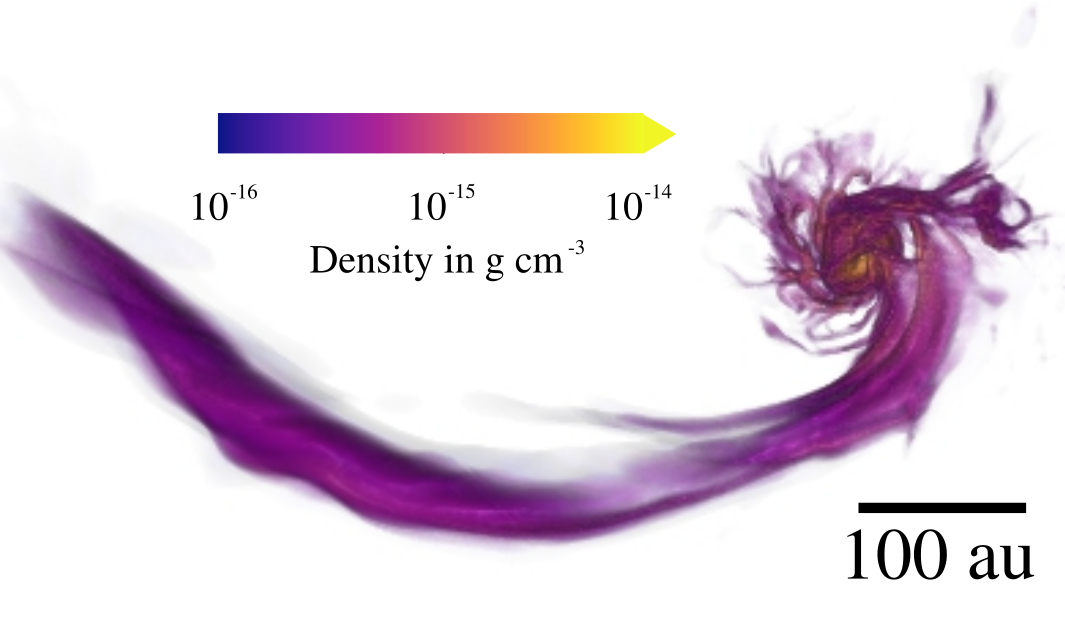
How did it begin?
Let's go back in time to the year 2014
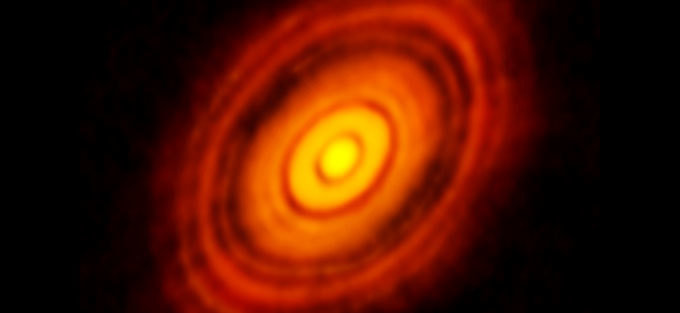
Wow!
Credit: ALMA (ESO/NAOJ/NRAO)
Credit:
DSHARP team

10 au
50 au
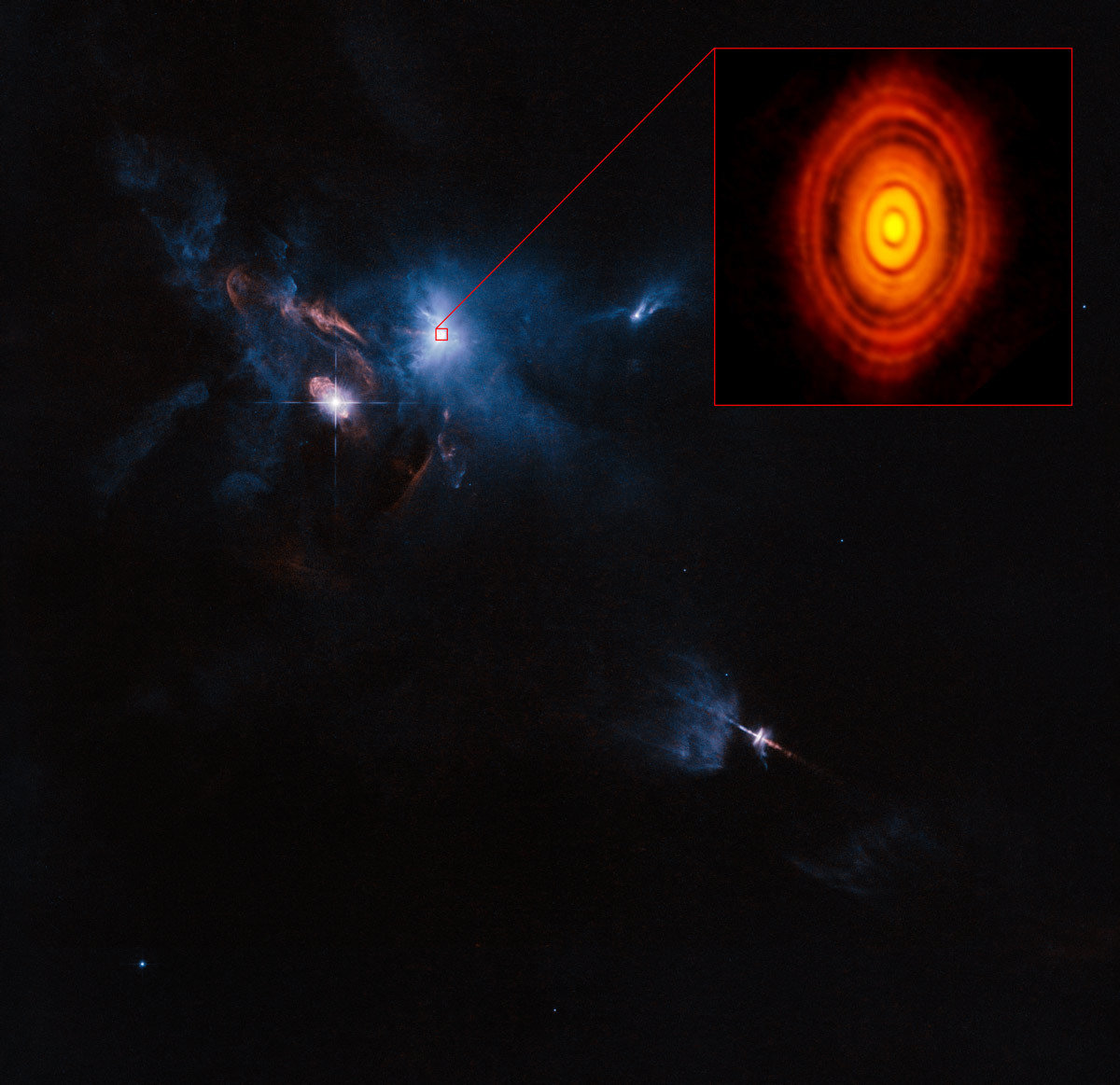
Credit: NASA/ESA Hubble space telescope &
ALMA (ESO/NAOJ/NRAO)
The big challenge:
link planet to star formation
50 au
The classical picture

Greene 2001
star formation
planet formation
History of modeling disk formation
spherical core collapse:
rotation
magnetization (mass-to-flux ratio)
non-ideal MHD effects
dust evolution
turbulence
useful for parameter studies
Bonnor-Ebert sphere
or uniform density
History of modeling disk formation

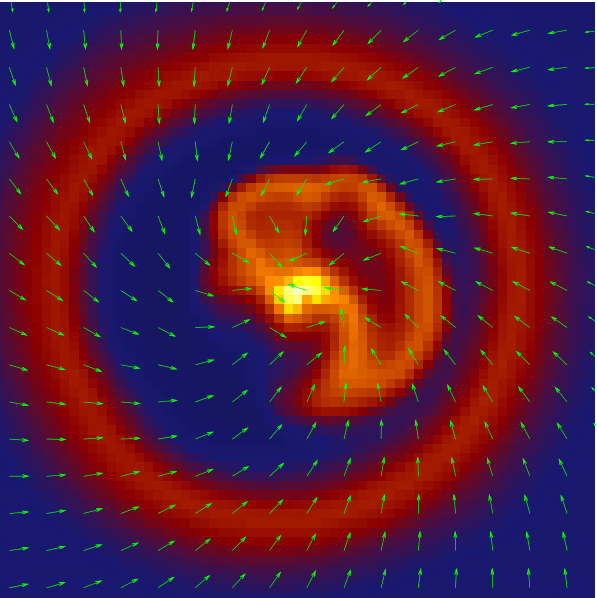

What about magnetic fields?
Help! Where is the disk?!
Santos-Lima et al. 2012
Hydro
ideal MHD
Magnetic braking catastrophe
Angular momentum is transported too efficiently away from the disk
magnetohydrodynamics
ideal MHD
Ohmic dissipation
Hall
ambipolar diffusion
Non-ideal
Non-ideal MHD
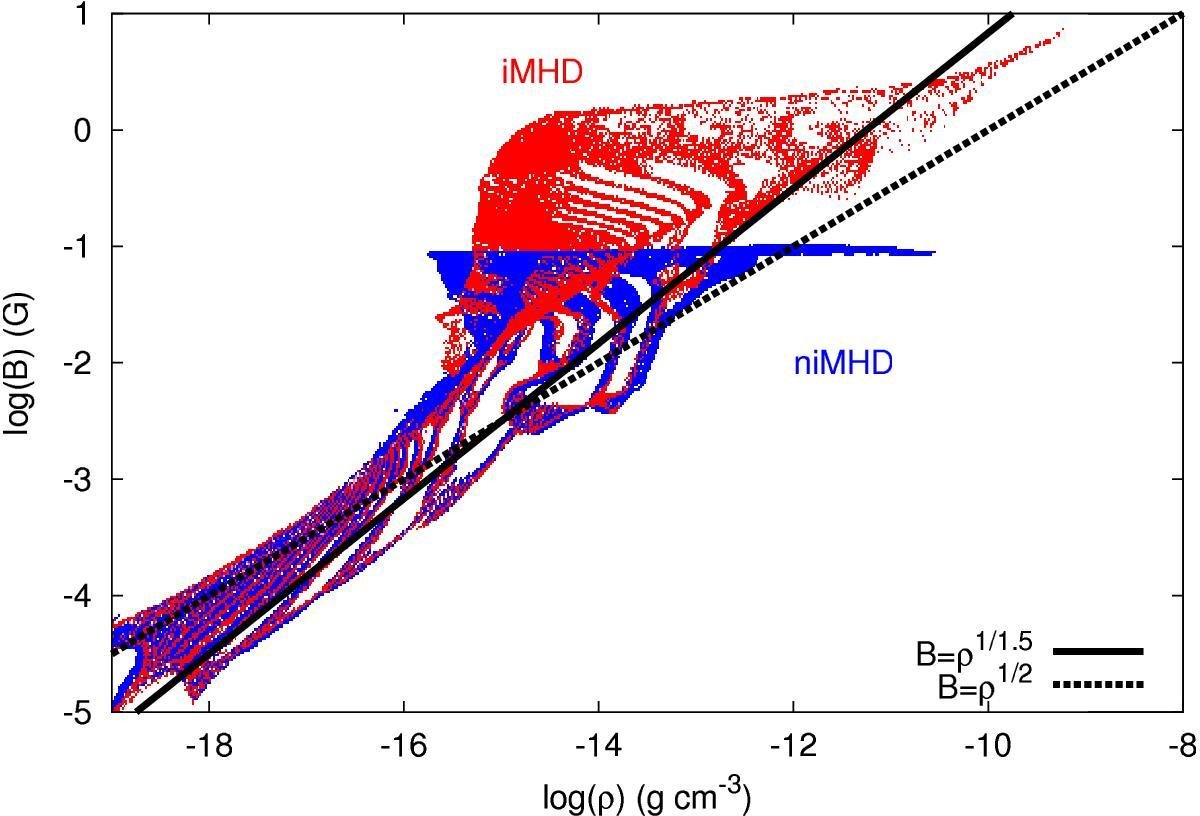
Masson et al. 2016
resistivities quench pile-up of magnetic field
avoids magnetic braking catastrophe
see Hennebelle et al. 2016 or Lee et al. 2021 for analytical studies
for more references see Wurster & Li 2018 (review)
History of modeling disk formation




What about magnetic fields?
Help! Where is the disk?!
Ohmic, Ambipolar, Hall
Santos-Lima et al. 2012
Hydro
ideal MHD
non-ideal MHD
non-ideal MHD is not a single parameter that is turned on or off
Achtung!
Resistivity depends on ionization rate
Küffmeier, Zhao & Caselli 2020
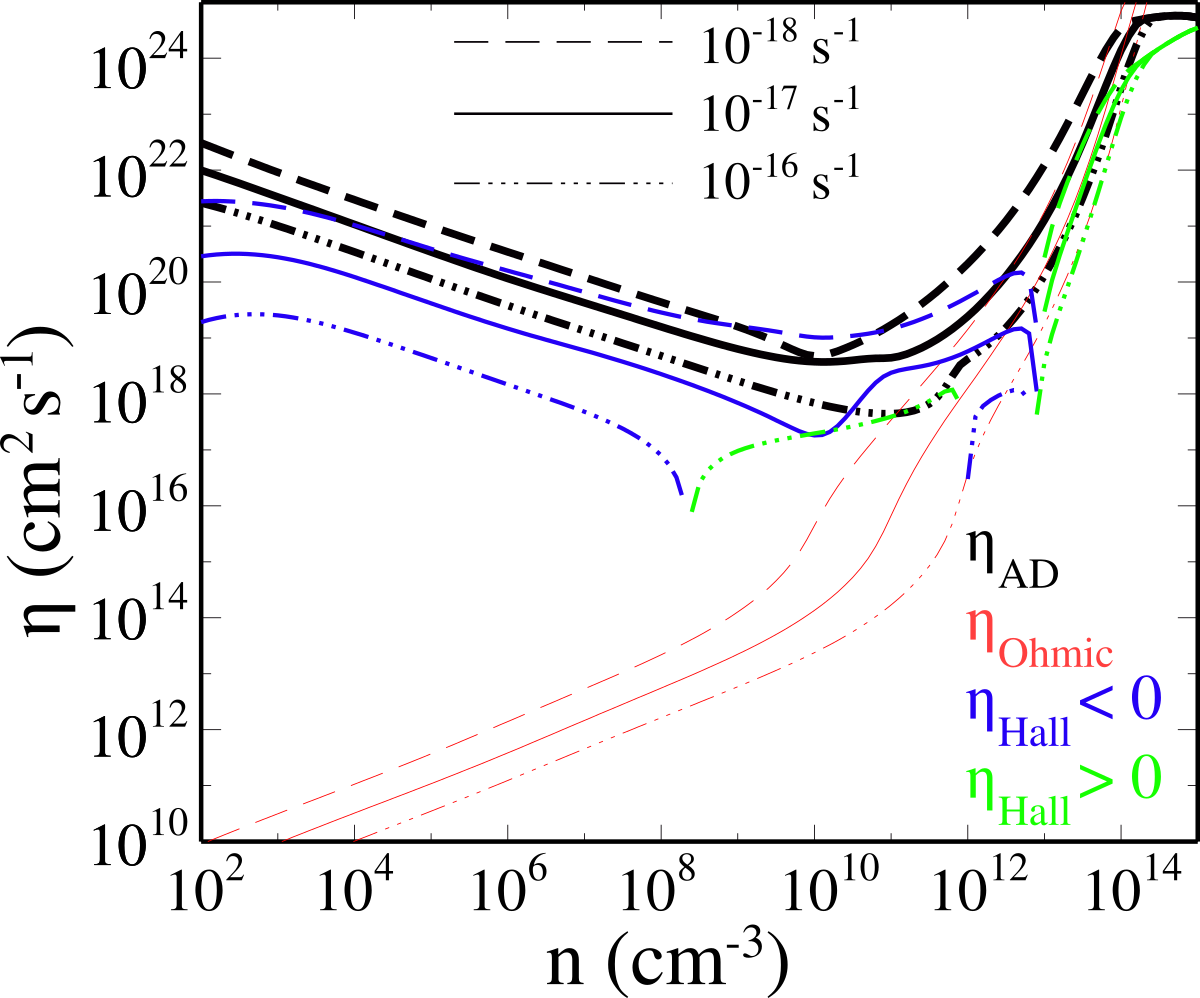
Question: What is the effect on disk formation when differing the ionization rate?
Effect of ionization on disk size
increasing ionization rate
enhanced magnetic braking
smaller disks
Küffmeier, Zhao & Caselli 2020

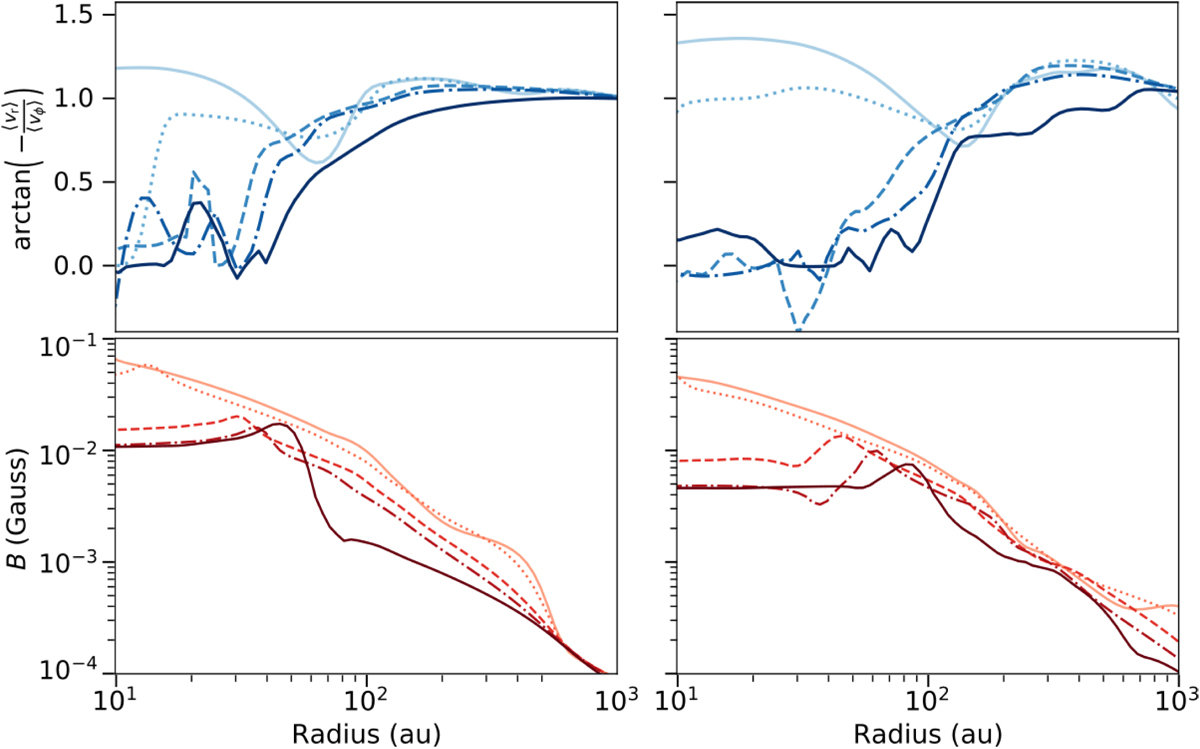

rotation
infall
from light to dark colors: high to low ionization rates
see also Wurster et al. 2018
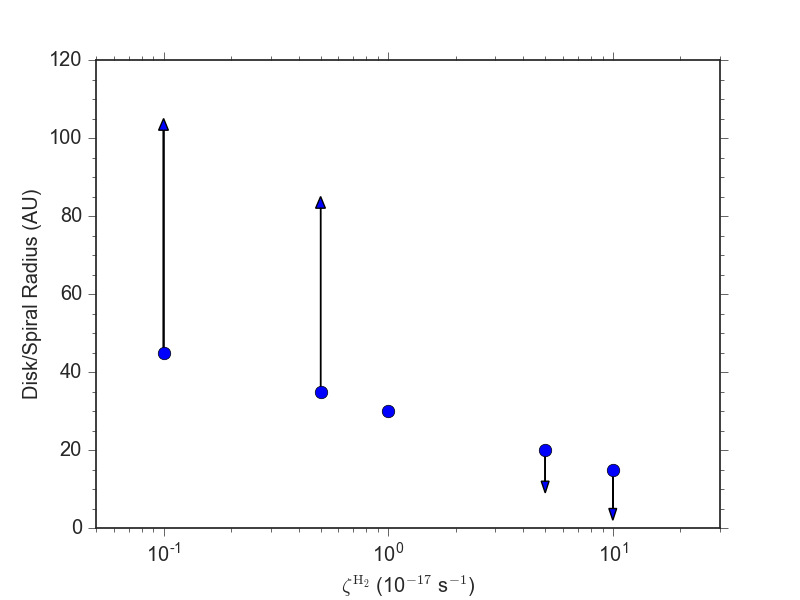
Disk size distribution
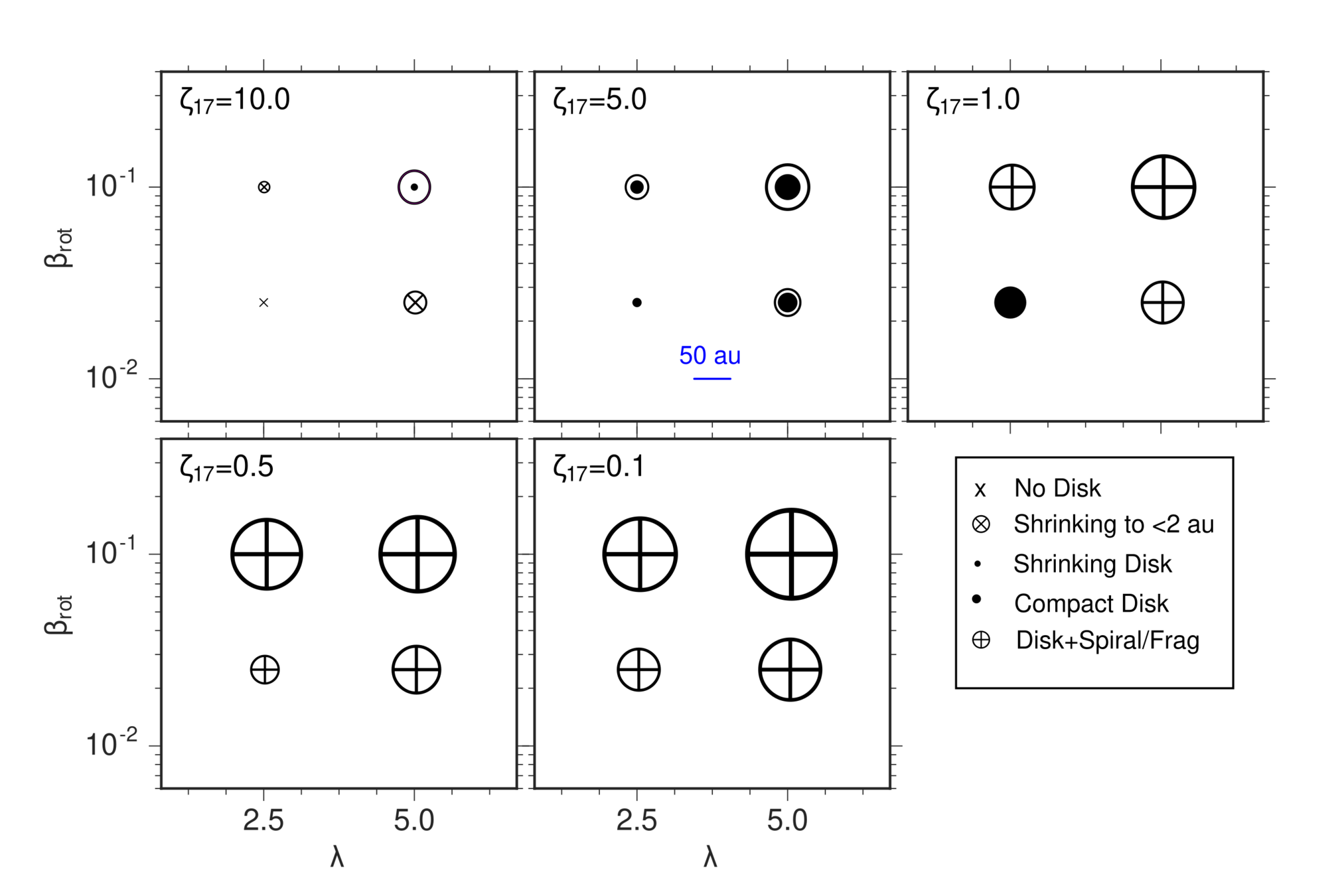
Küffmeier, Zhao & Caselli 2020
mass-to-flux ratio
initial strength of rotation
Disk size distribution

Tobin+ 2019
Are disks already born small in some regions?
What is the effect of local ionization rates?
Cosmic-ray ionization rate (or even Al-26)?
What about dust?




What about magnetic fields?
Help! Where is the disk?!
Ohmic, Ambipolar, Hall
Santos-Lima et al. 2012
Hydro
ideal MHD
non-ideal MHD
dust growth weakens magnetic braking => larger disks
Zhao et al. 2018, Marchand et al. 2020
dust-rich disks from collapse
"ash-fall" scenario
Tsukamoto et al. 2021
Lebreuilly et al. 2020
dust accumulates
What fraction of the gas and dust returns to the disk after being ejected by an outflow?
Key question
Credit: Tsukamoto et al. 2021
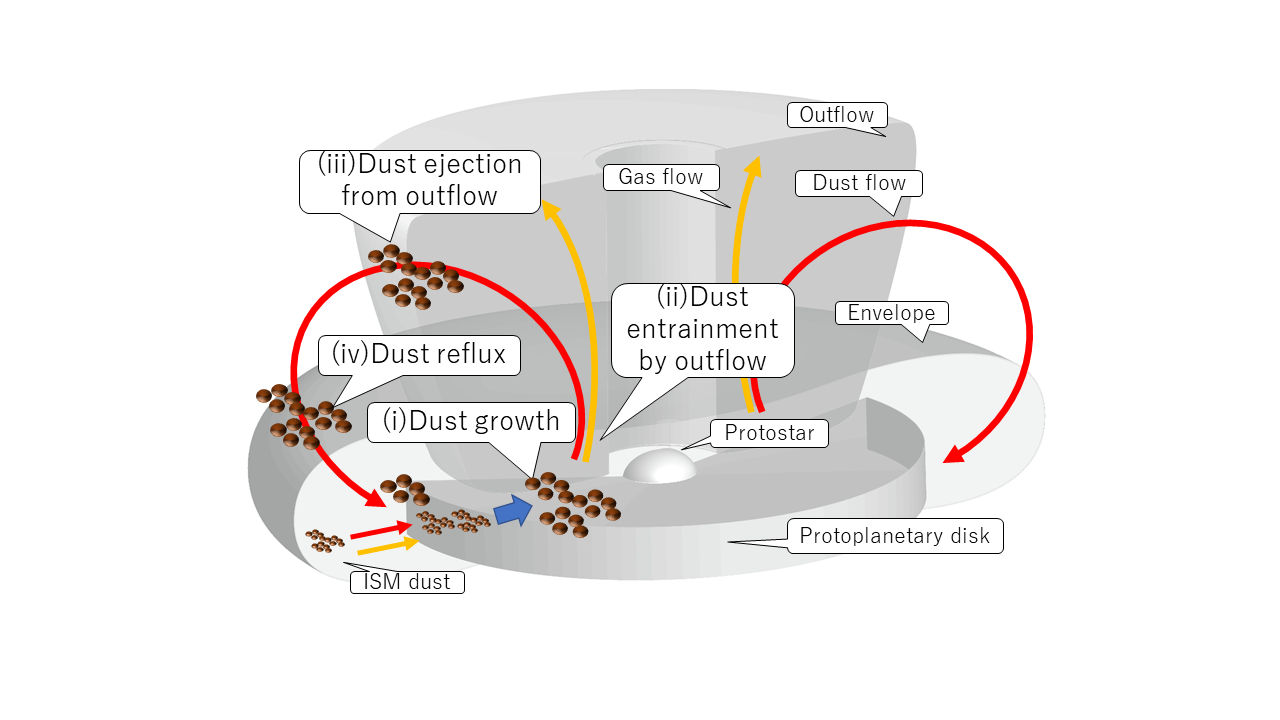
"Ash-fall" scenario aka conveyor belt
Increase in dust-to-gas ratio because dust can grow in disk and return
Tsukamoto et al. 2021
Is this the full picture?
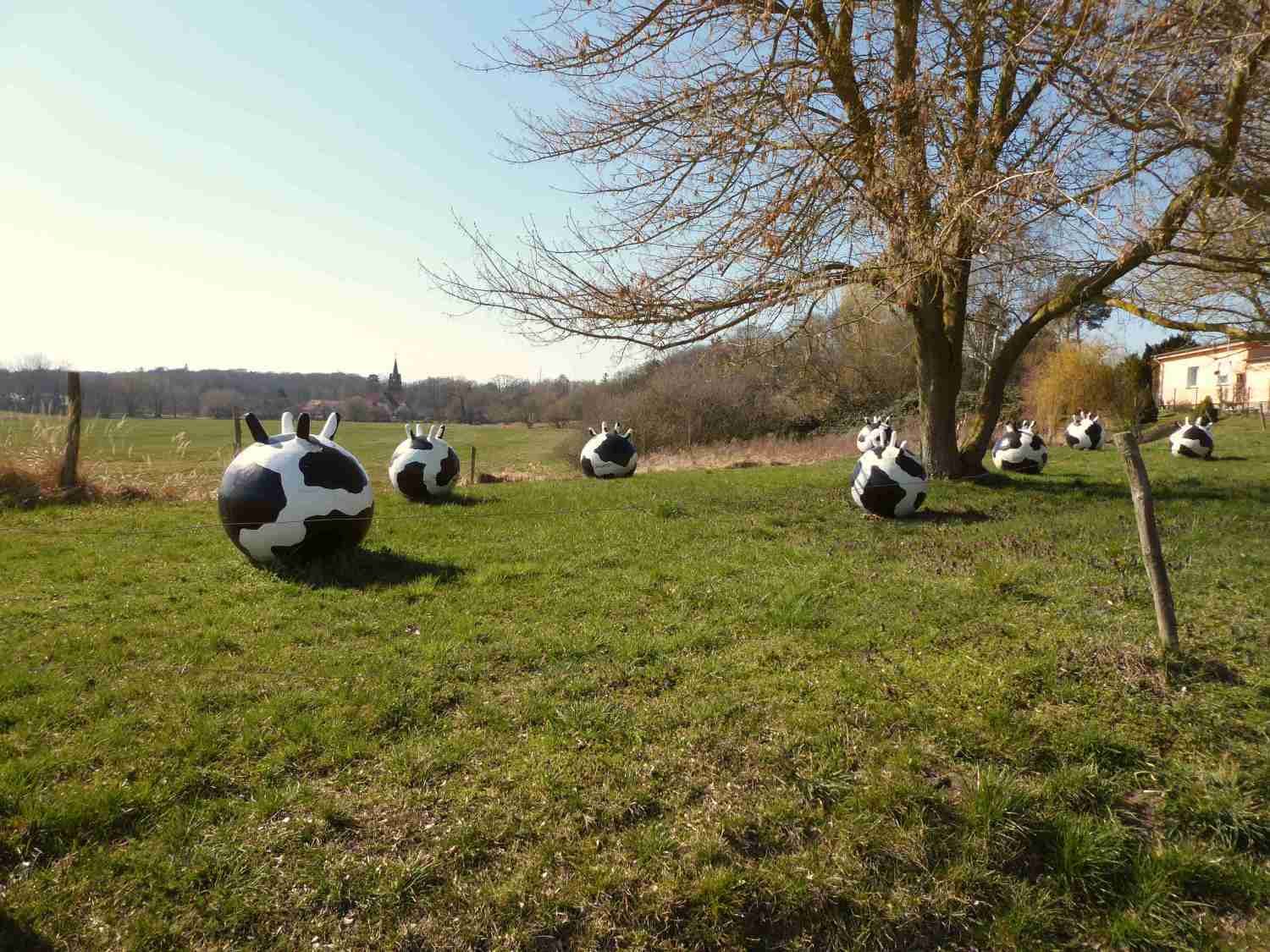
Streamers!



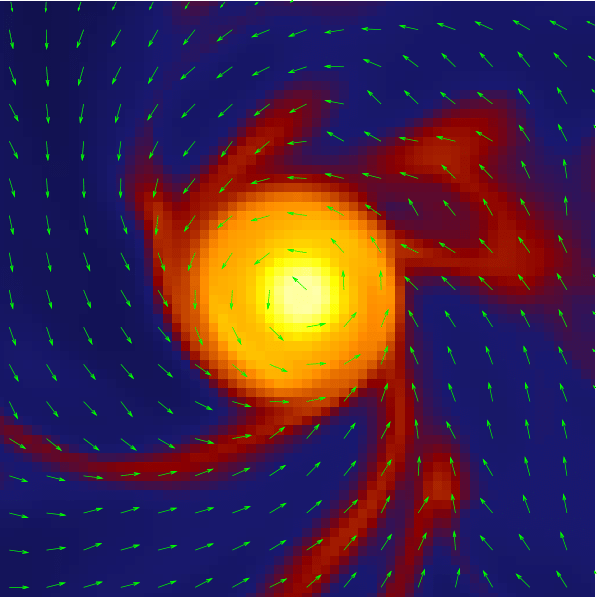

What about magnetic fields?
Help! Where is the disk?!
Ohmic, Ambipolar, Hall
Turbulence
Santos-Lima et al. 2012
Hydro
ideal MHD
non-ideal MHD
turbulence + MHD
Other effect: dust
dust growth weakens magnetic braking => larger disks
Zhao et al. 2018, Marchand et al. 2020
dust-rich disks from collapse
"ash-fall" scenario
Tsukamoto et al. 2021
Lebreuilly et al. 2020
dust accumulates

Credit: ALMA (ESO/NAOJ/NRAO)
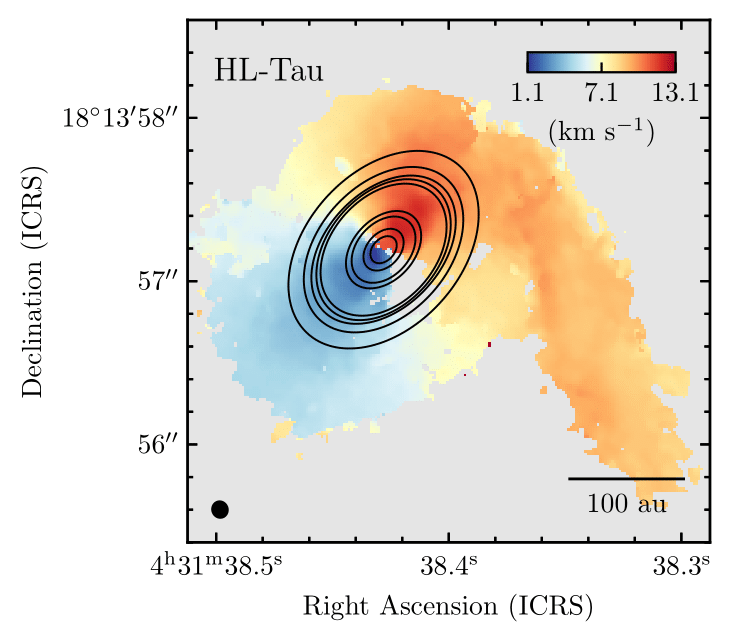
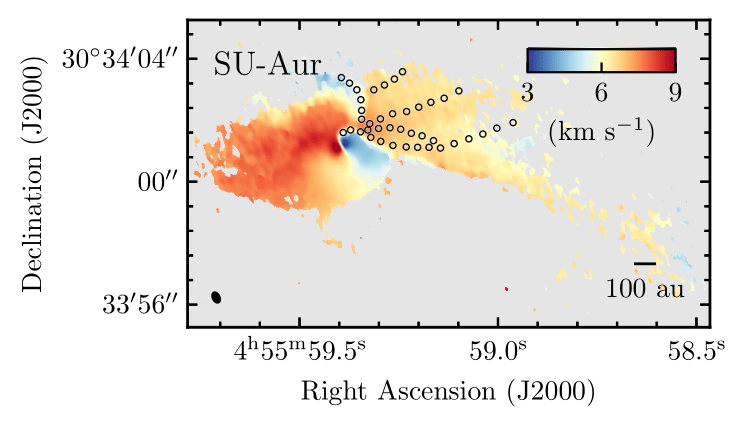
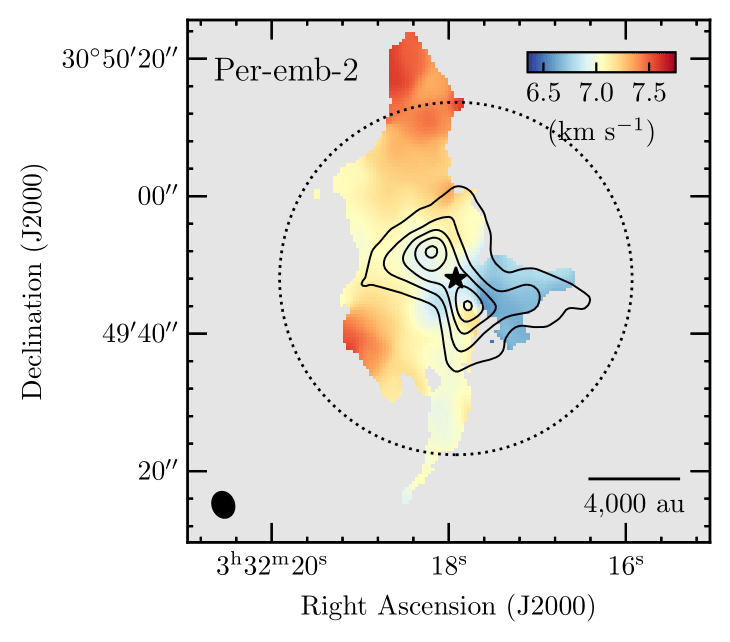
Ginski et al. 2021
Yen et al. 2019
Garufi et al. 2021
Pineda et al. 2020
50 au
see also:
BHB1 (Alves et al. 2020), GM Aur (Huang et al. 2021), IRS 63 (Segura-Cox in prep.), AB Aur (Grady et al. 1999 / Fukagawa et al. 2004), ...
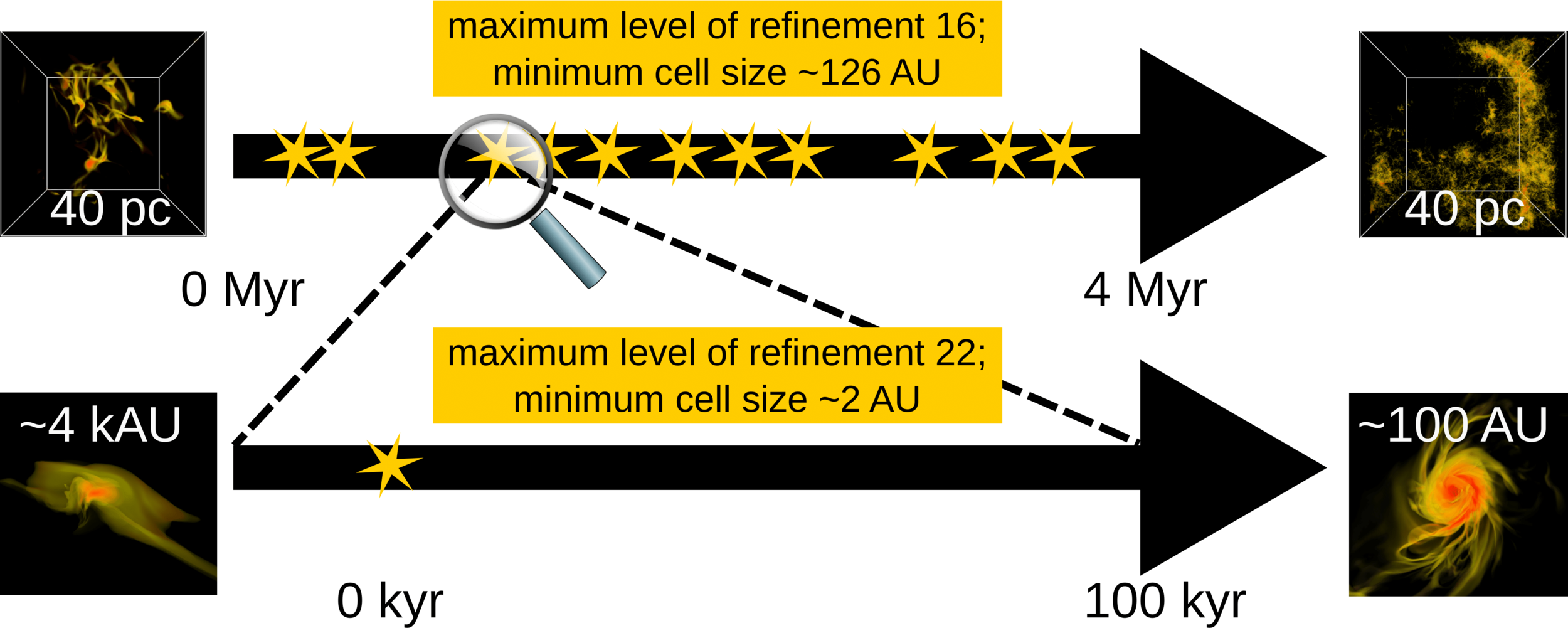
Zoom-in method
Küffmeier et al. 2017
- adaptive mesh refinement
- ideal magnetohydrodynamics
- turbulence driven by supernovae
- stars modelled as sink particles
Zoom-in on embedded protostars

Küffmeier, Calcutt & Kristensen 2019
bridge structure similar to IRAS 16293--2422 (e.g. Sadavoy+ 2018, van der Wiel+ 2019, Maureira+ 2020)
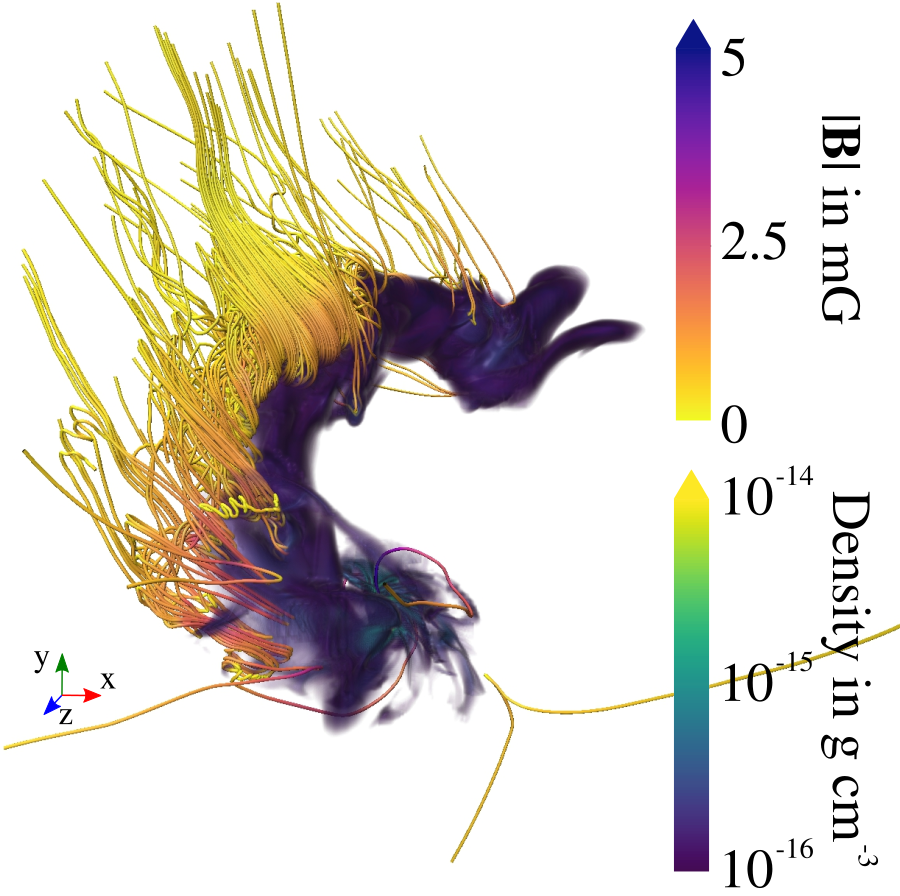
Küffmeier, Reißl et al. 2020
~1500 AU
Küffmeier et al. 2018
Formation of embedded protostellar multiple
Küffmeier, Reißl et al. 2020
Magnetic field in bridge

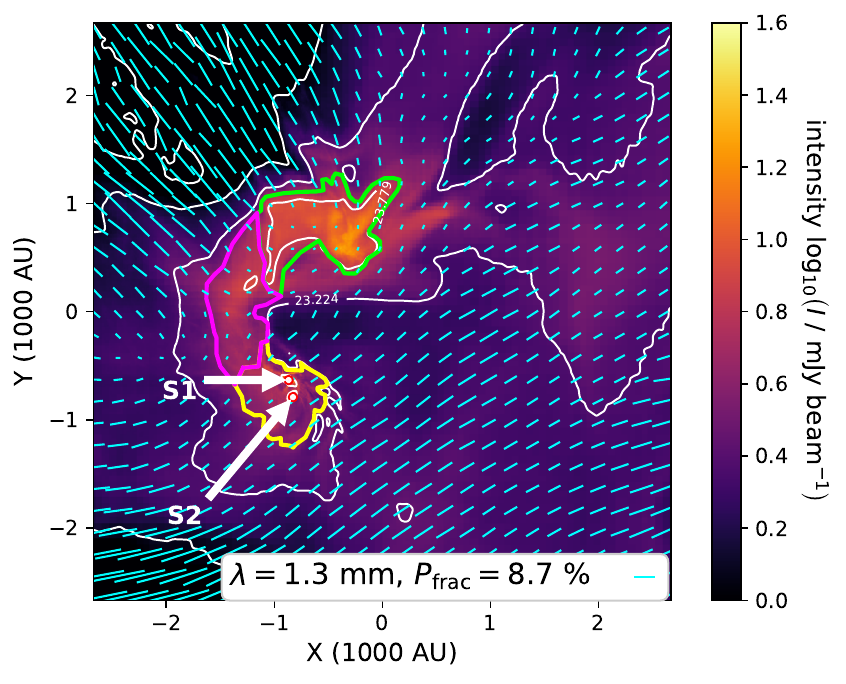
Synthetic observation with POLARIS
Field strength in bridge:
about 1 to 2 mG
Polarization fraction in bridge:
a few %
Synthetic dust polarization maps at 1.3 mm
Küffmeier, Reißl et al. 2020

Emitted radiation
Polarization fraction in bridge:
a few %
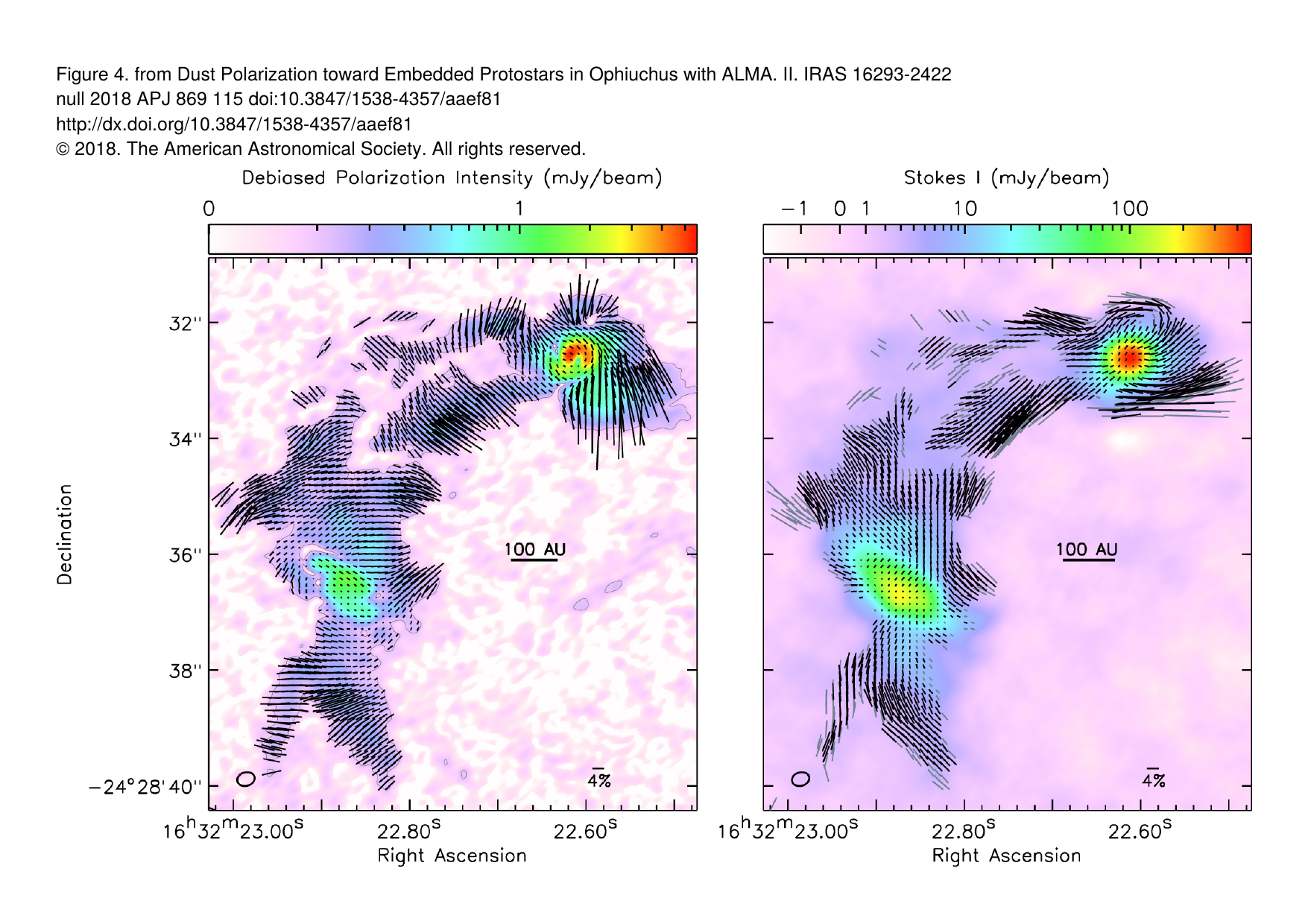
Polarization fraction in bridge:
up to 20 %
IRAS 16293--2422
Sadavoy et al. 2018
=> IRAS 16293-2422 is strongly magnetized
Wavelength dependence: 1.3 mm vs 53 micron

Emitted radiation
1.3 mm: good tracer of magnetic field
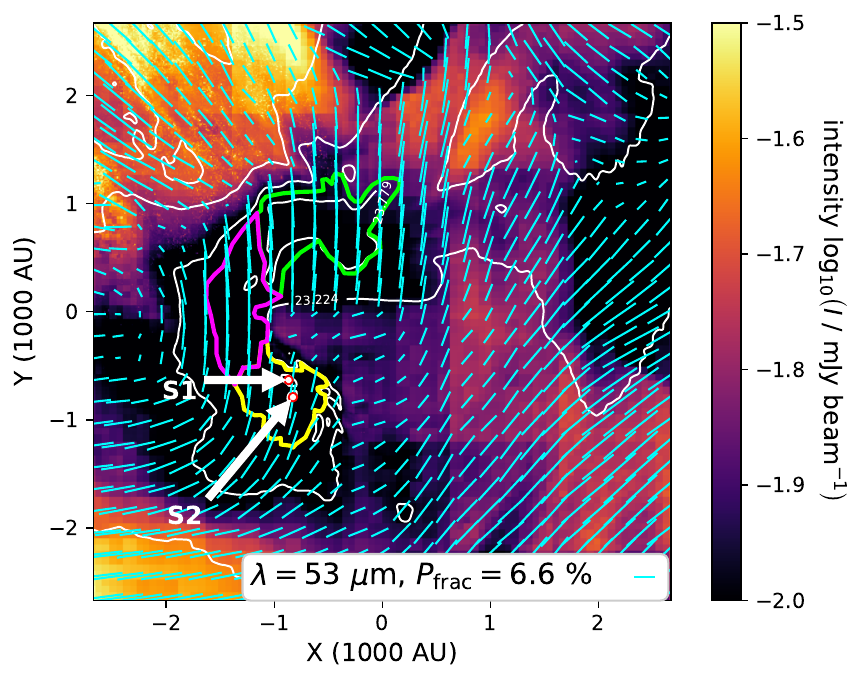
53 micron: poor tracer of magnetic field
Küffmeier, Reißl et al. 2020
Two reasons for wavelength dependence
Küffmeier, Reißl et al. 2020
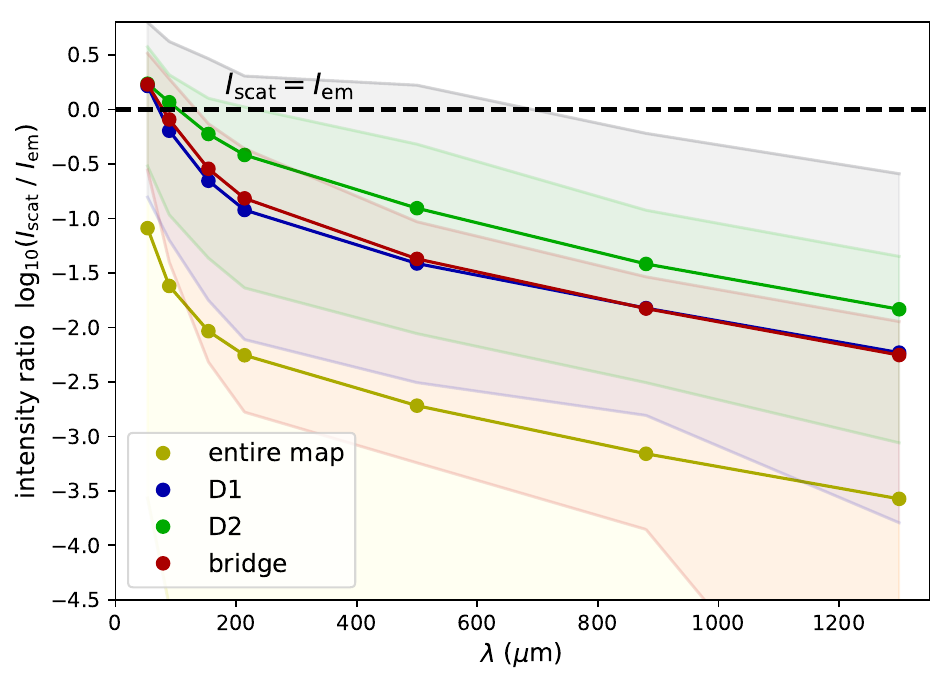
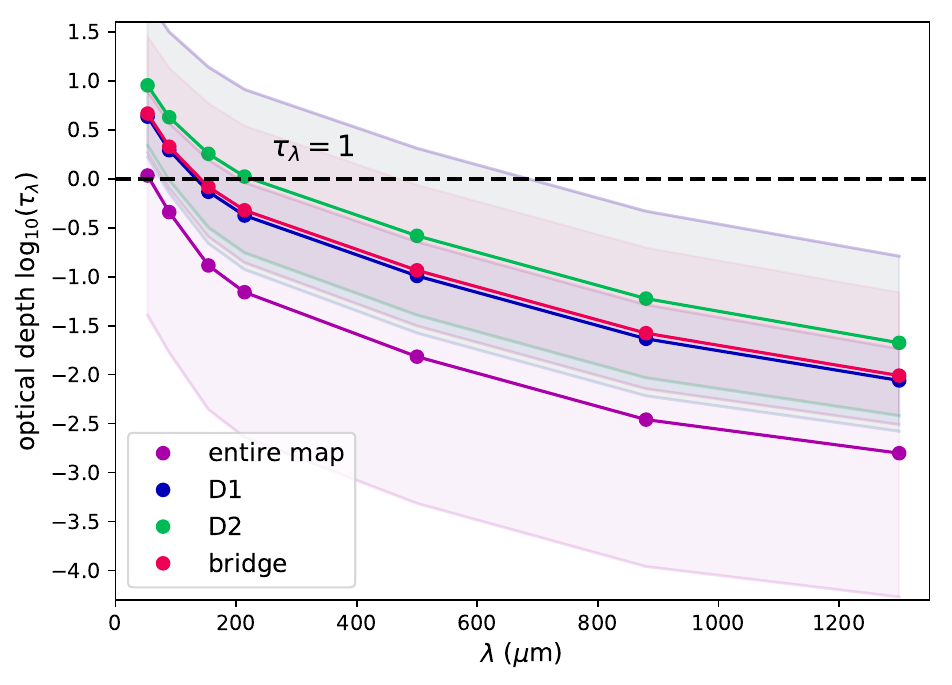
Self-scattering
Dichroic extinction
Take-away for scales beyond >100 au
< 200 micron: dichroic extinction and self-scattering; no trace of B
> 200 micron: thermal emission; linear polarization traces B
The connection to the larger scales

Küffmeier, Haugbølle & Nordlund 2017
Accretion is heterogeneous
Küffmeier, Haugbølle & Nordlund 2017
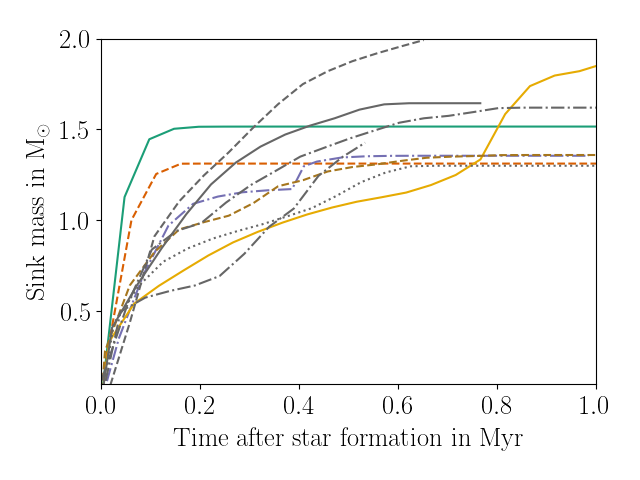
Observational indication: luminosity bursts
The connection to the larger scales

Küffmeier et al. 2017 / 2022 in prep.
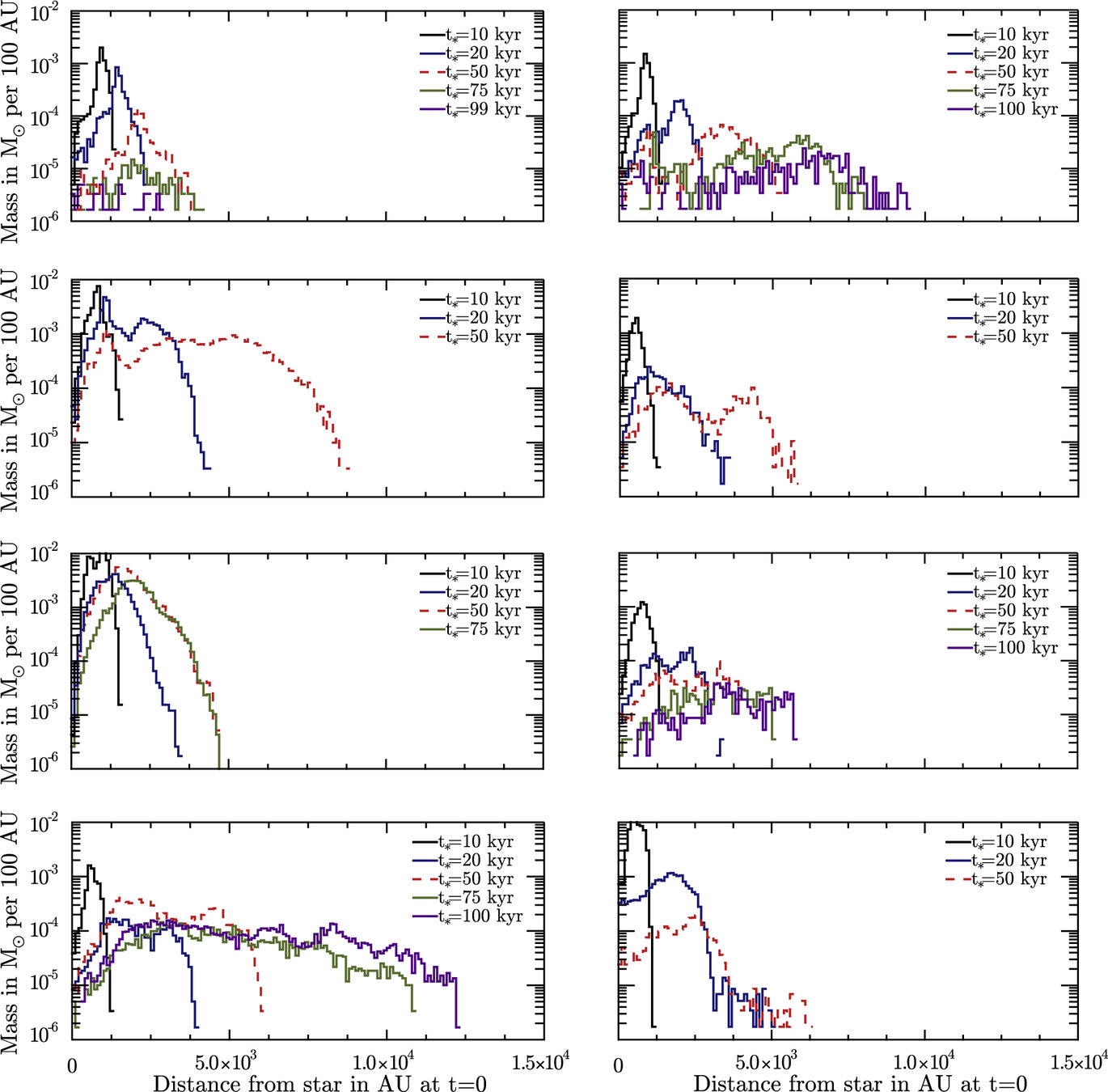
Gas from beyond the prestellar core can fall onto the star-disk system
Late infall happens more often than assumed
For solar mass stars ~50 % of final mass from beyond prestellar core! (Pelkonen et al. 2021)
Can disks be rejuvenated?
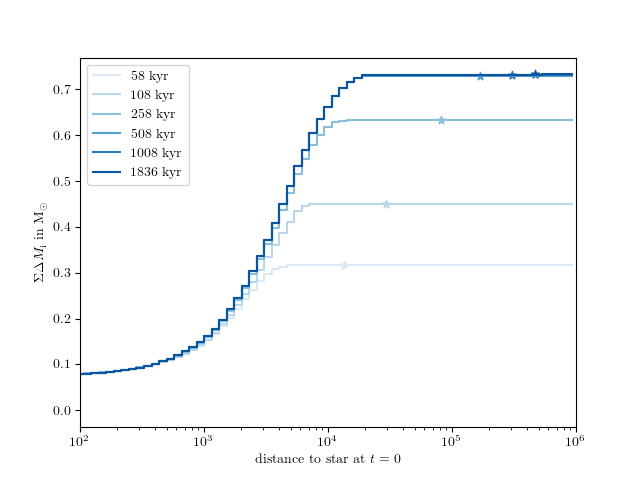
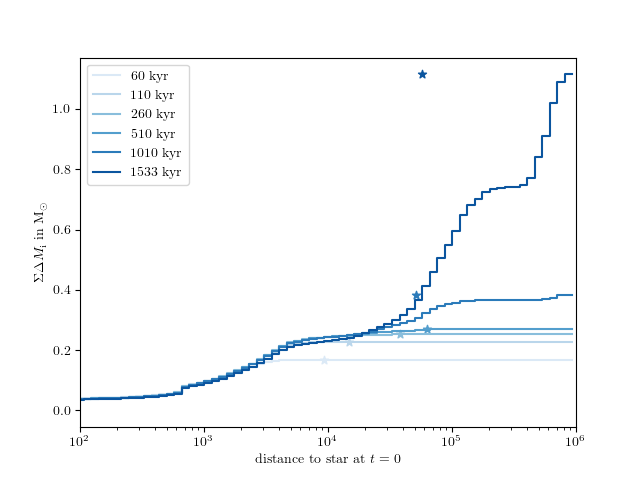
Küffmeier et al. 2022 in prep
Possibility of replenishing and refreshing the mass and chemical budget
Streamers (and shadows?) as signs of infall
Formation of misaligned configuration
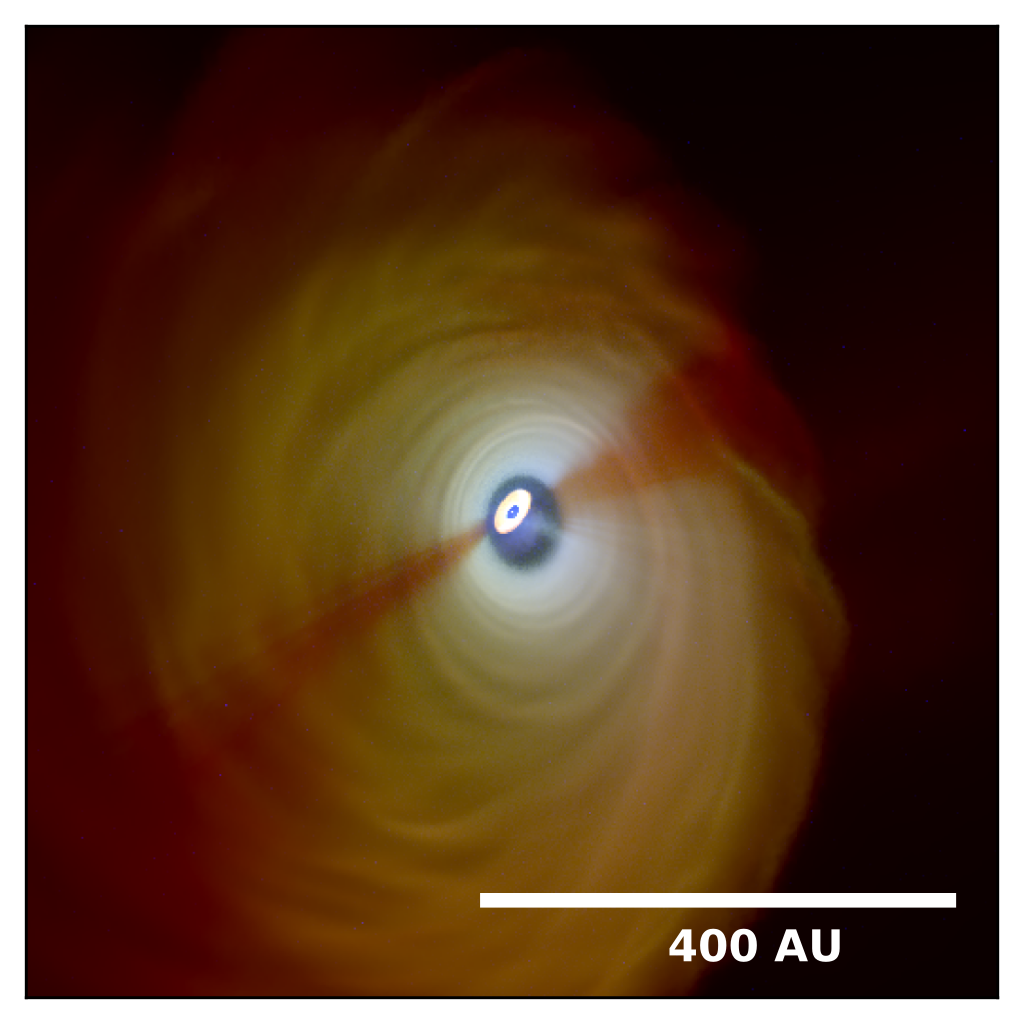
Observable as shadows in outer disk
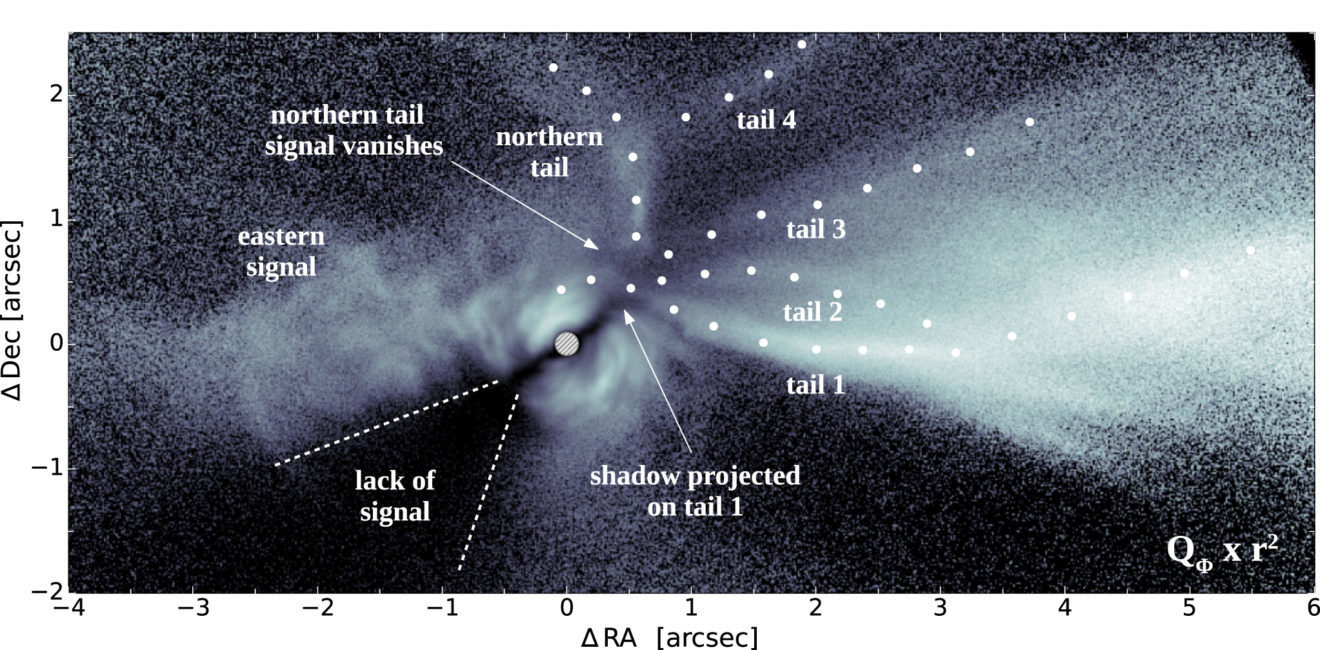
Ginski et al. 2021
Küffmeier, Dullemond et al. 2021
see also Bate 2018
Simulate cloudlet infall onto disk
AREPO, pure hydrodynamical
isothermal gas
vary infalling angle
vary rotation (prograde, retrograde)
Küffmeier, Dullemond, Reißl, Goicovic et al. 2021
Outer disk forms around inner disk
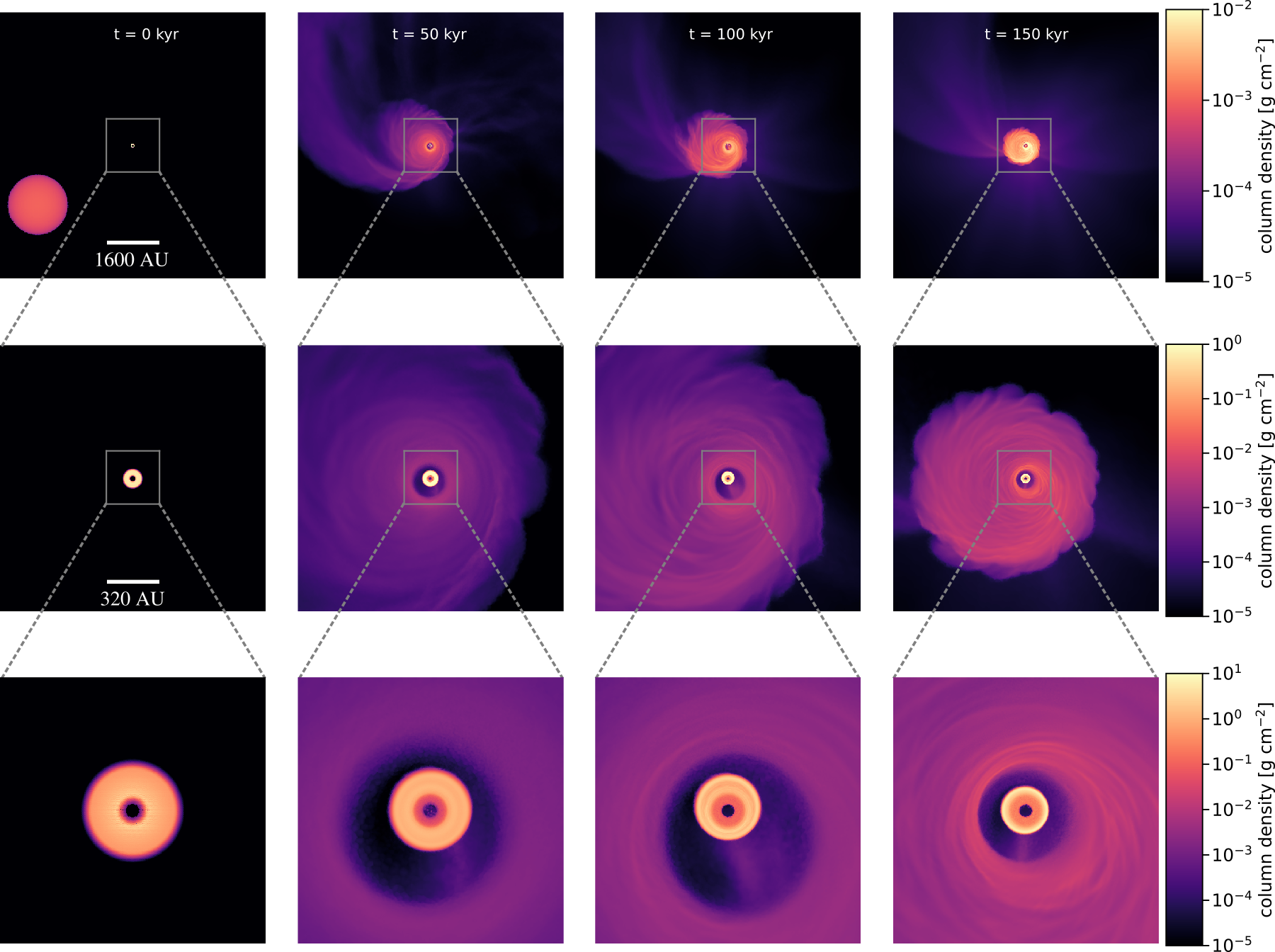
Küffmeier et al. 2021
Prograde vs. retrograde infall

Retrograde infall causes:
- counter-rotating inner and outer disk
- shrinking of inner disk
- enhanced accretion

- larger and deeper gap between disks
see also Vorobyov+ 2016
Küffmeier et al. 2021
Inner disk orientation

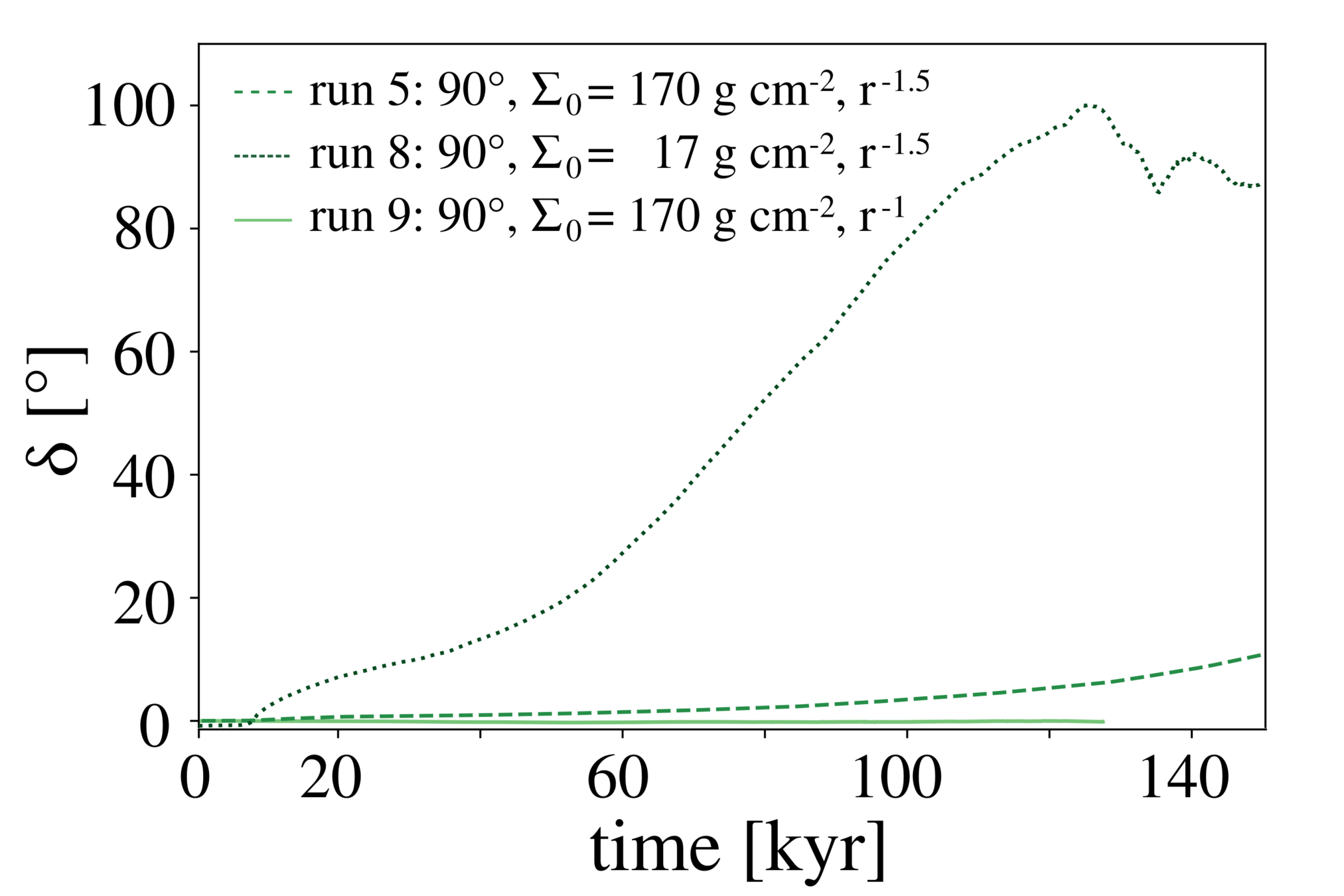
Küffmeier et al. 2021
Revised picture
Pineda ... Küffmeier et al. 'Protostars and Planets VII'
.
.
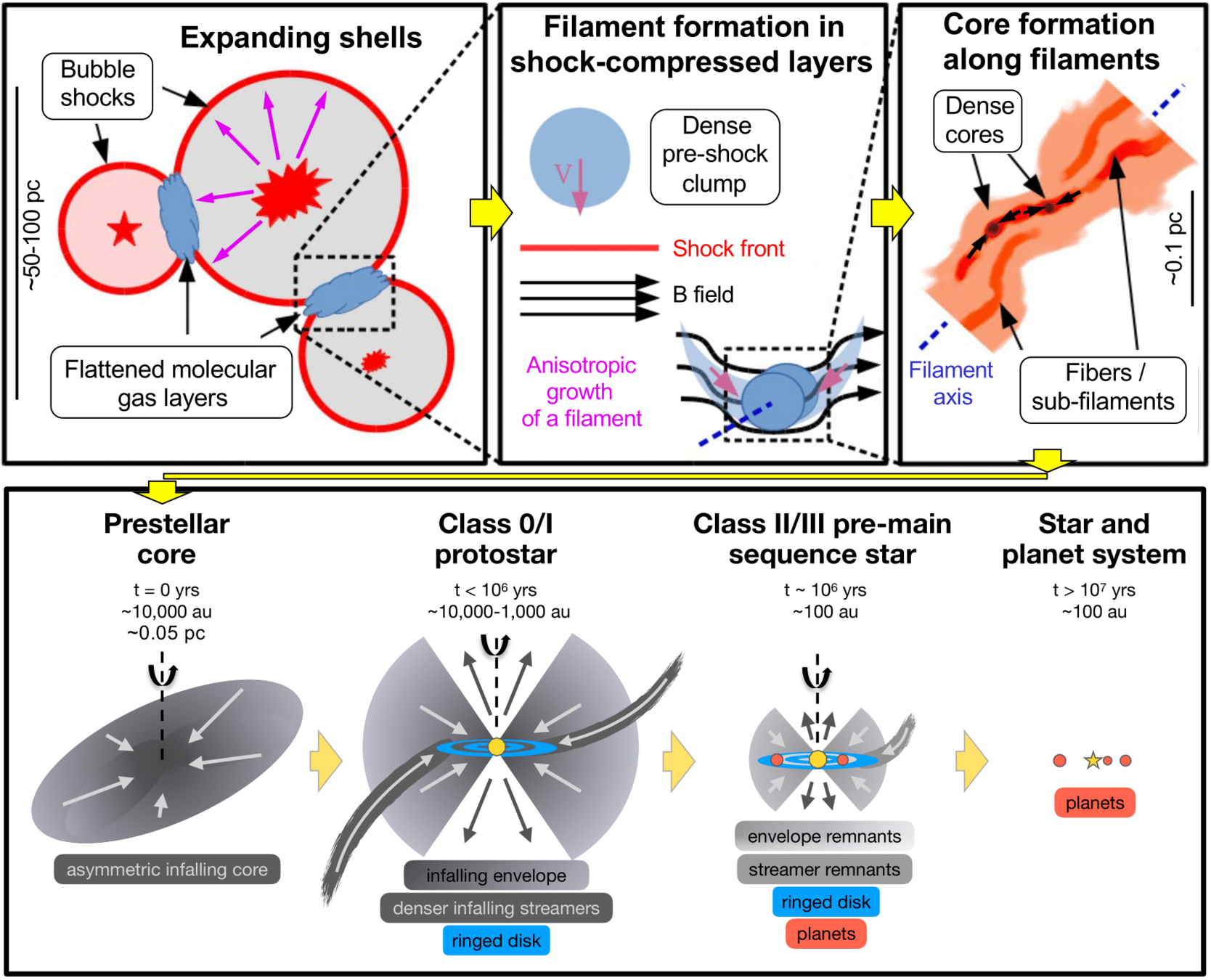
Segura-Cox et al. in prep.
Star and planet formation are two sides of the same medal
The disk is not a static entity, but rather a buffer zone
*we haven't even touched (proto-)stellar multiplicity

UF colloquium 2022
By kuffmeier
UF colloquium 2022
- 177



